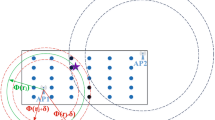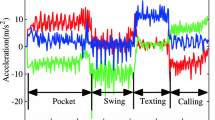Abstract
In this paper, we propose vertical and horizontal methods to reduce size of search area in indoor localization applications. Although, larger fingerprints means better accuracy, mostly indoor localization applications are running in mobile devices with limited battery, memory, and even processing power. In the proposed approaches, we reduce the size of fingerprints using reducing Access Points (APs) information (vertical reduction) and reducing fingerprint records (horizontal reduction). In vertical reduction, we focus on the importance of APs based on their appearance in fingerprint records. In horizontal reduction, we use regression and decision tree classifiers for primary location estimation. Then, only records in a predefined neighbourhood radius are selected for final localizations. Our studies show that the results of the vertical reduction approaches have a better performance against the results of the horizontal reduction approaches during the indoor localization phase. Also, these findings show that the best way to reduce the size of the fingerprints file is by removing the most common APs from the list.










Similar content being viewed by others
References
Liu, H., Darabi, H., Banerjee, P., & Liu, J. (2007). Survey of wireless indoor positioning techniques and systems. IEEE Transactions on Systems, Man, and Cybernetics, Part C (Applications and Reviews), 37(6), 1067–1080.
Liu, J. (2014). Survey of wireless based indoor localization technologies. Department of Science and Engineering, Washington University.
Jang, B., & Kim, H. (2018). Indoor positioning technologies without offline fingerprinting map: a survey. IEEE Communications Surveys and Tutorials, 21(1), 508–525.
Laoudias, C., Moreira, A., Kim, S., Lee, S., Wirola, L., & Fischione, C. (2018). A survey of enabling technologies for network localization, tracking, and navigation. IEEE Communications Surveys and Tutorials, 20(4), 3607–3644.
Zafari, F., Gkelias, A., & Leung, K. (2019). A survey of indoor localization systems and technologies. IEEE Communications Surveys and Tutorials, 21(3), 2568–2599.
Sattarian, M., Rezazadeh, J., Farahbakhsh, R., & Bagheri, A. (2019). Indoor navigation systems based on data mining techniques in internet of things: a survey. Wireless Networks, 25(3), 1385–1402.
Zhou, X., Chen, T., Guo, D., Teng, X., & Yuan, B. (2018). From one to crowd: a survey on crowdsourcing-based wireless indoor localization. Frontiers of Computer Science, 12(3), 423–450.
Singh, R., Macchi, L., Regazzoni, C. S., & Plataniotis, K. N. (2005). A statistical modelling based location determination method using fusion technique in WLAN. In International workshop on wireless ad-hoc networks
Kumar, C., & Rajawat, K. (2019). Dictionary-based statistical fingerprinting for indoor localization. IEEE Transactions on Vehicular Technology, 68(9), 8827–8841.
Abd El-Halim, M. A., Said, A. M., & El-Hennawy, H. (2019). A new statistical received signal strength (RSS) model based fingerprint approach for WLAN indoor localization application. In Proceedings of the 2019 21st international conference on advanced communication technology
Rizos, C., Dempster, A. G., Li, B., & Salter, J. (2007). Indoor positioning techniques based on wireless LAN. [Online]. https://opus.lib.uts.edu.au/bitstream/10453/19580/1/113_Li.pdf.
Majeed, K. H., Sorour, S., Al-Naffouri, T. Y., & Valaee, S. H. (2015). Indoor localization and radio map estimation using unsupervised manifold alignment with geometry perturbation. EEE Transactions on Mobile Computing, 15(11), 2794–2808.
Kul, G., Tansel, Ö., & Bülent, T. (2014). IEEE 802.11 WLAN based real time indoor positioning: literature survey and experimental investigations. Procedia Computer Science, 34, 157–164.
Iyer, K. T. (2015). Computational complexity of data mining algorithms used in fraud detection. A master of science thesis in industrial engineering, harold and inge marcus department of industrial and manufacturing engineering. Pennsylvania: The Pennsylvania State University.
Turgut, Z., Üstebay, S., Aydın, G.Z.G., & Sertbaş, A. (2019). Deep learning in indoor localization using WiFi. In International telecommunications conference, Singapore.
Abbas, M., Elhamshary, M., Rizk, H., Torki, M., & Youssef, M. (2019). WiDeep: WiFi-based accurate and robust indoor localization system using deep learning. In Proceedings of the 2019 IEEE international conference on pervasive computing and communications
Wang, X., Gao, L., & Mao, S. (2017). BiLoc: Bi-modal deep learning for indoor localization with commodity 5GHz WiFi. IEEE Access, 5, 4209–4220.
Koike-Akino, T., Wang, P., et al. (2020). Fingerprinting-based indoor localization with commercial MMWave WiFi: a deep learning approach. IEEE Access, 8, 84879–84892.
Li, S., Sun, Y., Rowe, W. S., Wang, X., Kealy, A., & Moran, B. (2019). Practical evaluation of a crowdsourcing indoor localization system using hidden Markov models. EEE Sensors Journal, 19(20), 9332–9340.
Li, Y., Williams, S., Moran, B., & Kealy, A. (2019). A probabilistic indoor localization system for heterogeneous devices. IEEE Sensors Journal, 19(16), 6822–6832.
Kim, H., Hwang, D. Y., Kim, K. H., & Jung, J. J. (2017). Reducing positioning errors in the important access point selection method for fingerprint localization by spatial partitioning. In International conference on information networking.
Mariakakis, A., Sen, S., Lee, J., & Kim, K. H. (2014). SAIL: single access point-based indoor localization. In Proceedings of the 12th annual international conference on Mobile systems, applications, and services.
Jiang, P., Zhang, Y., Fu, W., Liu, H., & Su, X. (2015). Indoor mobile localization based on wi-fi fingerprint’s important access point. International Journal of Distributed Sensor Networks, 11(4), 1–8.
Patel, F. N. (2016). Large high dimensional data handling using data reduction. In International conference on electrical, electronics, and optimization techniques.
Manning, C. D., Raghavan, P., & Schutze, H. (2008). Introduction to Information Retrieval. New York: Cambridge University Press.
Jekabsons, G., & Zuravlyov, V. (2010). Refining Wi-Fi based indoor positioning. In Proceedings of the 4th international scientific conference applied information and communication technologies (AICT), pp 87–95.
Lohan, J. T. E.S. (2015). WLAN RSS indoor measurement data. Tampere University of Technology. https://www.cs.tut.fi/tlt/pos/meas.htm.
Wang, Y., Xiu, C., Zhang, X., & Yang, D. (2018). WiFi indoor localization with CSI fingerprinting-based random forest. Sensors, 18(9), 2869.
Liu, H., & Motoda, H. (2007). Computational methods of feature selection. Boca Raton: CRC Press.
Robnik-Šikonja, M., & Kononenko, I. (2003). Theoretical and empirical analysis of ReliefF and RReliefF. Machine learning Journal, 53(1–2), 23–69.
Funding
Funding was provided by Arak University (Grant No. 96/5829).
Author information
Authors and Affiliations
Corresponding author
Additional information
Publisher's Note
Springer Nature remains neutral with regard to jurisdictional claims in published maps and institutional affiliations.
Rights and permissions
About this article
Cite this article
Ghaffarian, H. Reducing Search Area in Indoor Localization Applications. Wireless Pers Commun 117, 1243–1258 (2021). https://doi.org/10.1007/s11277-020-07920-z
Accepted:
Published:
Issue Date:
DOI: https://doi.org/10.1007/s11277-020-07920-z




